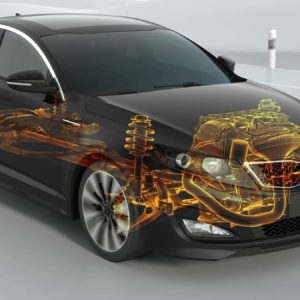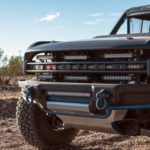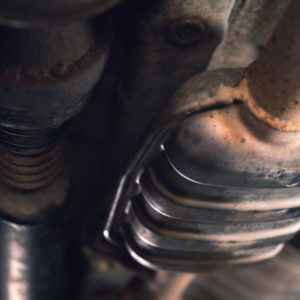Racing stripes refer to the pair of lines you usually see running up the hood, over the top, and extending down a car’s rear. A lot of car owners add racing stripes to their vehicles either by using impermanent decals or by going to a paint shop.
While racing stripes were originally used in racing cars, they became standard on a lot of road cars, particularly American muscle cars. In this article, we’ll discuss the history and meaning of racing stripes on a car.

A Brief History of Racing Stripes
Racing stripes were first used in the famous 24 Hours of LeMans by a team owned by American Millionaire sportsman Briggs Cunningham. During this era, teams didn’t have unique liveries on the cars. Instead, FIA rules stipulated that the cars were painted with colors that represented their countries. Cunningham painted his cars white with blue stripes, colors that represented the stripes of the American flag. This paint scheme made Cunningham’s cars instantly recognizable and was first referred to as “Cunningham stripes.”
Peter Brock was a high-school student when he saw Cunninghan’s cars. He was able to race a customized 1946 Ford convertible with a Cadillac V8 engine. He adopted the white-car-with-blue-stripes look that he saw on Cunningham’s cars for his own car.
After Cunningham, the pair of stripes didn’t catch the public’s eye again until the ’60s when Brock became a designer for Shelby American. One of his tasks was to create an original paint design for a Shelby model based on Ford’s new Mustang fastback. The cars were to be entirely white, with a distinctive look without a lot of unique logos or additional body parts. Brock gave the 1965 Ford Mustang Shelby GT350 the same white and blue stripes that Cunningham first used.
People at the factory called them “Le Mans stripes,” but official literature sent to the dealers referred to them as “Rallye stripes.” Roughly half of the cars that Shelby American made from 1965 to 1966 had them. Meanwhile, the Shelbys used in racing were given a Guardsman Blue paint job with white stripes. This color combination was used in so many races that it had become Shelby America’s signature look.

What Are Racing Stripes For?
Do racing stripes serve a practical purpose? Not really. Briggs Cunningham put stripes on his cars to help his team more easily identify them on the track. This allowed pit crews to keep tabs on their cars during a race, when they can be sandwiched in a field of cars.
There was a story going around in the 1960s that the stripes were supposed to help disoriented drivers see the direction the car was facing even if it was enveloped in a cloud of dust, but this is likely just an urban legend and there is no evidence of this ever happening.
That said, the racing stripes on a car that will never see a day on the track aren’t useless even if they mostly just cosmetic. They make a car look better while paying homage to the legacy of 1960s muscle cars.
Car Racing Stripes Design
Adding racing stripes on your vehicle can be quite easy since you can purchase vinyl decal stickers online that mimic the racing stripe designs.
Racing stripes can come in different designs. There’s no doubt that the most common design is two solid lines that sit side by side. These are the racing stripes that you’ll see on muscle cars like a Ford Mustang or Dodge Charger.
Another popular design is composed of a thick stripe flanked by two thinner stripes running down the middle of a vehicle.
Another type of racing stripe is offset to one side of the vehicle rather than centered. These racing stripe designs might feel odd or jarring, but offset stripes are meant to create a visually striking and unique appearance that breaks the norm. It can also highlight a particular feature or detail.
Any information provided on this Website is for informational purposes only and is not intended to replace consultation with a professional mechanic. The accuracy and timeliness of the information may change from the time of publication.
















I always thought the stripes were a drivers aid when orienting the front end on corners.